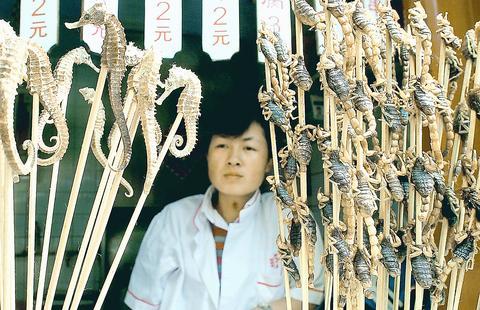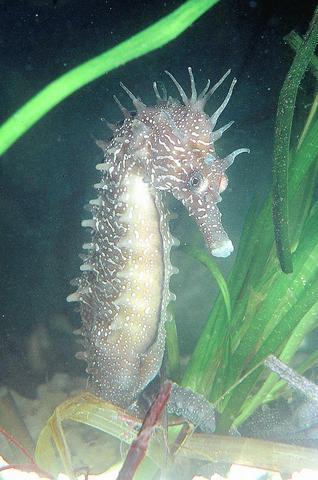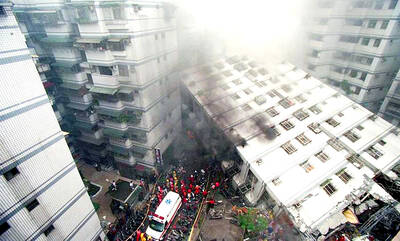Seahorses are their own worst enemy.
Fished to the point of extinction for the traditional Chinese medicine market, they mate for life and their unwillingness to seek new partners after being separated has done little to improve their chances of survival.
One of their better hopes for conservation may lie in the unlikeliest of places -- a ramshackle shed perched on the edge of the Atlantic Ocean.

PHOTO: REUTERS
Seahorse Ireland says its goal is to help save the species by cultivating seahorses born in captivity for the growing aquarium market.
"We want to make people aware that the captive-bred seahorse is a much better buy," said production manager Ken Maher, from the makeshift laboratory in Connemara, west Ireland.
"There's no deleterious effect on the environment and the seahorse will survive and flourish in your tank."

PHOTO: REUTERS
Seahorses are no ordinary sea creatures, notwithstanding their monogamy which is highly unusual for the animal kingdom. It is the male who receives eggs from his female partner and fertilizes them himself.
"The female swims up to her chosen male partner and the two change color as they dance around each other for hours in an elaborate courtship ritual," said Maher.
After receiving eggs from the female and fertilizing them himself, the male is pregnant for about three weeks before giving birth.
Captive-bred
The low-cost technology pioneered by Seahorse Ireland could be transferred to poorer parts of the world where seahorse stocks are fast becoming depleted.
Next year, a ban on international trade in seahorses, unless they are captive-bred or for scientific purposes, is due to come into operation, a move likely to cripple the livelihoods of thousands of dependent fishermen.
"Other conservation bodies try to say `this is a sanctuary, no fishing is allowed here,' and try to get locals to make arts and crafts instead," Maher said.
"But these people are fishermen who want to live near the sea. I know I could not switch to making arts and crafts if I was in their position."
If no alternative was provided, the trade would simply go underground, Maher said.
An estimated 40 million seahorses a year are taken from the wild for traditional Chinese medicine in which they are used as an aphrodisiac as well as a range of ailments including heart disease.
Demand has risen in recent years to such an extent that seahorses retail for about US$1,900 a kilogram in Asia, almost the price of gold.
A further one million are fished for the curio trade because seahorses retain their shape and color when dried.
The pet trade takes another one million, but very few survive beyond a few months or so without live food.
Frozen food
That's where Seahorse Ireland comes in -- it trains captive-born seahorses to get used to frozen food.
"Once we train them to take frozen food, they can be sent all over the world," said Maher.
Set up three years ago by Maher and his fellow marine biologist Kealan Doyle, Seahorse Ireland has two key advantages right on its doorstep.
First, the larger of the two seahorse species local to Ireland, the spiny seahorse, can be found in seagrass beds in and around nearby Kilkieran Bay.
In addition, the west coast of Ireland offers an abundance of zooplankton enriched by nutrients from the Gulf Stream, and the company has developed a system to extract and freeze this food.
Maher dismissed criticism from some environmentalists that breeding seahorses in captivity will serve only to boost demand, heaping more pressure on rapidly-declining stocks.
Capable of spawning 200 offspring at a go in the wild, with the right conditioning seahorses could breed closer to 1,000 juveniles, Maher said.
The company aims to sell seahorses for the pet market, retailing from 200 euros each, over the Internet, to be dispatched for next-day delivery.
"Seahorses travel quite well in tightly packed bags, with oxygen, just like goldfish," Maher said.
Sales are forecast at around 30,000 next year and around 70,000 the year after. Over time, Maher said there were plans to open a visitor center, using the seahorse as an icon for other endangered species.
"We will use it as a focus for conservation because it's not just the panda in China or the river dolphin in India that are in need of help," he said.

Seven hundred job applications. One interview. Marco Mascaro arrived in Taiwan last year with a PhD in engineering physics and years of experience at a European research center. He thought his Gold Card would guarantee him a foothold in Taiwan’s job market. “It’s marketed as if Taiwan really needs you,” the 33-year-old Italian says. “The reality is that companies here don’t really need us.” The Employment Gold Card was designed to fix Taiwan’s labor shortage by offering foreign professionals a combined resident visa and open work permit valid for three years. But for many, like Mascaro, the welcome mat ends at the door. A

If China attacks, will Taiwanese be willing to fight? Analysts of certain types obsess over questions like this, especially military analysts and those with an ax to grind as to whether Taiwan is worth defending, or should be cut loose to appease Beijing. Fellow columnist Michael Turton in “Notes from Central Taiwan: Willing to fight for the homeland” (Nov. 6, page 12) provides a superb analysis of this topic, how it is used and manipulated to political ends and what the underlying data shows. The problem is that most analysis is centered around polling data, which as Turton observes, “many of these

Since Cheng Li-wun (鄭麗文) was elected Chinese Nationalist Party (KMT) chair on Oct. 18, she has become a polarizing figure. Her supporters see her as a firebrand critic of the ruling Democratic Progressive Party (DPP), while others, including some in her own party, have charged that she is Chinese President Xi Jinping’s (習近平) preferred candidate and that her election was possibly supported by the Chinese Communist Party’s (CPP) unit for political warfare and international influence, the “united front.” Indeed, Xi quickly congratulated Cheng upon her election. The 55-year-old former lawmaker and ex-talk show host, who was sworn in on Nov.

Even the most casual followers of Taiwan politics are familiar with the terms pan-blue and pan-green. The terms are used so casually and commonly with the assumption that everyone knows what they mean, that few stop to really question it. The way these terms are used today is far broader and extensive than what they were originally created to represent. Are these still useful shorthand terms, or have people become so obsessed with them that they color perceptions to the point of distortion? LEE TUNG-HUI WAS NO SMURF People often assume that these terms have been around forever, or at least as